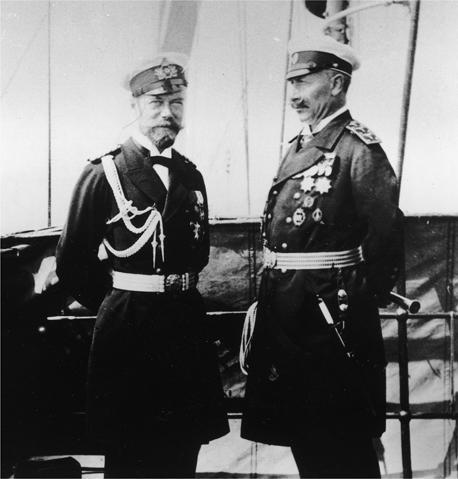The Rasputin File (91 page)
Authors: Edvard Radzinsky

Anna Vyrubova with the tsarina. ‘Everyone continues to castigate Vyrubova behind her back and to curry favour to her face…. All these lords are afraid of one thing only, holding onto their warm little places, although they care little for Russia’, wrote one courtier in her diary.

Two group photographs were taken in March 1914 in Rasputin’s St Petersburg apartment and later widely disseminated. For the first time it is possible to identify most of those shown.
Above: ‘Alexandra (Sana) Pistolkors and her husband Alexander are standing against the wall — a stout, well-groomed, tall young gentleman, and next to him, his wife with her childlike little porcelain face and her great belly (she was pregnant). Next, the young man with a moustache who strains to lift his face above the others is in fact, Leonid Molchanov, who identified those shown to the Extraordinary Inquiry in 1917. Still in the back row, and barely visible, is Prince Zhevakhov, brought by his colleague Pistolkors, and who would, thanks to his devotion to Rasputin be rewarded in September 1916 with the appointment of deputy chief procurator of the Most Holy Synod.
‘Next two rank-and-file characters, Ervin Khristoforovich Gill, the husband of a pretty devotee of Rasputin’s, and Nina Dmitrievna Yakhimovich, a tall, broad-shouldered lady and one of his truly uncomplaining devotees. And then Molchanov named two figures of greater significance: Olga Vasilievna Loman and her daughter Nadezhda. This was the family of Dmitry Loman, who has been mentioned many times by us as the builder and warden of the tsars’ favourite Feodor Cathedral in Tsarskoe Selo. The young woman with the hard, cold face standing to the right of Olga Loman and her daughter is another very important figure from Rasputin’s future life. She is Anna Ivanovna Reshetnikova, the daughter of the very rich and very old Moscow merchant’s wife Anisia Reshetnikova, with whom Rasputin often stayed in Moscow.

‘In the second row is Sophia Volynskaya, a beautiful, not very young Jew … the wife of the agronomist Volynsky … Next comes Anna Vyrubova, with her large fleshy moon-like face, and next to her the old woman in mourning is Alexandra Guschina, the inconsolable widow who met Rasputin during prayer. The good-looking woman beside her in the fashionable bonnet with the plume is Yulia (Lili) Dehn, after Vyrubova the tsarina’s closest friend.
‘And, finally — the rough, short old peasant man with the shaggy hair and beard, a kind of minor of pagan god, a Russian Pan, is none other than Rasputin’s father.
‘In the first row are devotees Zina Timofeeva, Maria Golovina, Maria Gill on Rasputin’s right, with Olga Kleist, and sitting on the floor a heavy-set woman with the wide, stubborn peasant face, Akilina Laptinskaya. She too was one of the keepers of Rasputin’s secrets.’
In the other photograph Molchanov stands with his back to the door. To the Extraordinary Commission he recalled that besides Rasputin the group included ‘Madame Golovina, Madame Gill, Dehn, a woman who had come from Siberia with some request for Rasputin, an old woman from Vasiliev Island, and Rasputin’s older daughter Matryona.’

Mikhail Rodzyanko, Speaker of the Duma, who introduced himself to the eight-year-old tsarevich as ‘the largest, fattest man in Russia.’

Maurice Paléologue, the influential French ambassador in St Petersburg, whose gossipy diaries remain an important source as to what court and society were saying about Rasputin immediately before and during the first world war.

The full list of this St Petersburg police gathering is no longer available, but number 3 is Stephan Beletsky, director of the Department of Police, and next to him (third from right) is Vladimir Dzhunkovsky, the chief of gendarmes, who controlled the political police. ‘He could amuse the royal children with his very fine bird calls.’

Cartoons mocking Rasputin’s position were widely distributed. In addition to the tsar and tsarina, Anna Vyrubova (left) looks up lovingly.

Nicholas with the German Kaiser Wilhelm, a first cousin of the tsarina. ‘From the beginning of 1914, everyone simultaneously started predicting there would be a war. And the tsar, who had just come back from Germany, sensed that its emperor, the martial “Uncle Willy,” was no longer opposed to going to war.’

‘And once again [Nicholas] listened with approval to the warlike dreams of the Grand Duke Nikolai Nikolaevich. And felt with joy the popularity of his own mood. The young Russian bourgeoisie wanted war, and so did the old aristocracy … the army’s favourite, the six-and-a-half-foot tall Grand Duke Nikolai Nikolaevich.’

The Russian Council of Ministers in June 1915 at the tsar’s headquarters at Baranovich Station. Front row, from right: State Controller P.A. Kharitonov, Grand Duke Nikolai Nikolaevich, Nicholas II, Chairman of the Council of Ministers L.I. Goremykin, Minister of the Imperial Court, General-Adjutant V.B. Fredericks; back row, from right: Minister of Internal Affairs Prince N.B. Shcherbatov, Minister of Information S.V. Rukhlov, Minister of Foreign Affairs S.D. Sazonov, Minister of Agriculture A.V. Krivoshein, Minister of Finance P.L. Bark; Head of Staff, Commander-in-Chief of the Infantry A.A. Polivanov; Minister of Trade and Industry Prince V.N. Shakhovskoy, unidentified.

